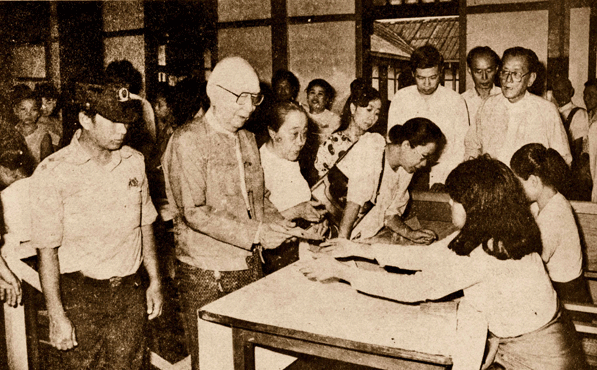Here Today, Gone Tomorrow

The assassination of Aung San in July 1947, just six months before Burma was to regain its independence, and deep ideological divisions did not prevent the AFPFL from forming successive governments over the next 15 years. Its chief political rival was the National United Front (NUF), formed ahead of the April 1956 general election.
Like the AFPFL, the NUF was ideologically diverse. It included an array of smaller parties: the Burma Workers and Peasants Party, the Justice Party, the People’s Unity Party, the People’s Progressive Party and the People’s Peace Front, as well as several youth organizations and ethnic groups. Both the AFPFL and the NUF brought together groups spanning the political spectrum from left to right, as well as powerful individuals and interest groups, including students, war veterans, peasants, workers and ethnic minorities.
In 1958, the AFPFL split into the “Clean” faction led by Prime Minister U Nu and Thakin Tin and the “Stable” faction led by Ba Swe and Kyaw Nyein. In June of that year, U Nu’s government survived a no-confidence vote by eight votes with the support of the NUF (which had also divided along factional lines). Facing growing instability, U Nu invited Gen Ne Win to form a military caretaker government.
Ne Win handed power back to U Nu in April 1960, two months after the “Clean” AFPFL faction, now transformed into the Pyidaungsu [Union] Party, won a landslide victory in a general election. But Burma’s brief era of parliamentary democracy was soon to end for good when Ne Win mounted a coup in March 1962.
Although the internal power struggles of Burma’s political parties had left many Burmese confused and disillusioned, what followed was far worse. For the next 26 years, a single party, Ne Win’s Burma Socialist Programme Party (BSPP), ruled without any challengers. In March 1964, the ruling military council decreed the Law Protecting National Unity, abolishing all political parties except the BSPP.
In 1974, a one-party system was formally established under a new constitution approved through a sham referendum. Political persecution became the norm, and all dissenting views were ruthlessly suppressed. Far from fostering unity, the Ne Win regime exacerbated divisions, prolonging conflicts with ethnic minorities and Communist insurgents by using military might, rather than political dialogue, as a means of resolving differences.
By 1988, growing resentment of Ne Win’s misrule forced the BSPP to give up its monopoly on power. A nationwide uprising resulted in the collapse of the government, and a new military junta, the State Law and Order Restoration Council, took over, promising a return to multiparty politics. On Sept. 27, 1988, just over a week after seizing power, the regime issued the Political Parties Registration Law. Under this law, the BSPP reconstituted itself as the National Unity Party (NUP) and became just one of 236 parties registered by the Multiparty Election Commission.
Among the other parties that came into existence at that time: the National League for Democracy (NLD), led by Aung San Suu Kyi; the League for Democracy and Peace, led by U Nu; the student-led Democratic Party for a New Society and the Students’ Revolutionary Party for Democracy; and ethnic-based parties such as the Shan Nationalities League for Democracy (SNLD) and the Arakan League for Democracy.
The nation went to the polls on May 27, 1990. Even after the Election Commission disqualified 143 parties for various reasons before the election, there were still so many remaining that none was expected to win the election outright—that, at any rate, was the junta’s calculation.
In a major upset of the regime’s plans, however, the NLD won a stunning 392 out of 492 seats, earning it the right to form the next government. But that never happened, because the junta refused to honor the results. Nearly 20 years later, it continues to detain many of the NLD’s leaders, including Suu Kyi, along with elected members of parliament from other parties.
At present, there are just 10 legally registered parties in Burma, including the NLD, the SNLD and the NUP. More will be formed ahead of next year’s election, but it remains to be seen whether they will be permitted to reflect the diversity of Burmese society or the overwhelming desire of most Burmese citizens for a return to genuine democracy.
For nearly a century, political parties have played a key role in the effort to define the common goals of Burma’s people while allowing them to express their differences. Since colonial times, they have struggled for independence, ideological influence, democratic change or ethnic rights.
By suppressing them, the military has not only eliminated what it regards as a cacophony of clashing voices; it has also robbed Burma of much of its vitality, with disastrous consequences.
« previous 1 | 2 |
